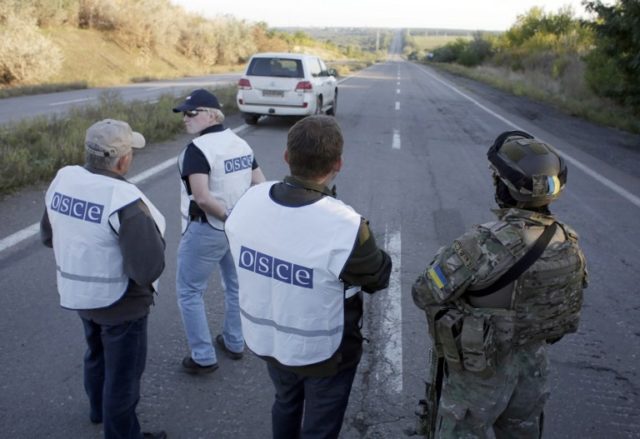
OSCE Officials Reveal Concept for International Mission in Ukraine’s East
Publication: Eurasia Daily Monitor Volume: 16 Issue: 11
By:

Moscow is no longer inclined, even pro forma, to consider the terms of a United Nations peace mission in Ukraine’s east. A full year has elapsed since the Kremlin’s negotiator on this issue (and overseer of Ukraine’s Russian-occupied territory), Vladislav Surkov, last consented to meet with the US State Department’s special envoy, Kurt Volker, in Dubai, in January 2018. Since then, the Russian side has rebuffed Volker’s efforts to reactivate the discussion about the terms of a UN peace mission.
This persistent blockage has apparently caused Kyiv and Washington to consider possible alternatives to a UN mission. On January 28, Volker and Ukraine’s ambassador to the United Nations, Volodymyr Yelchenko, met to discuss possible steps toward an “international peace mission” in Ukraine’s east (Ukrinform, January 28, 2019). The term “international,” rather than United Nations as heretofore, denotes that a joint UN-OSCE (Organization for Security and Cooperation in Europe) mission is now being considered. It looks like a tentative move at this juncture, possibly seeking a middle way between the Ukrainian and US preference for a large and “robust” UN-led military contingent versus Moscow’s idea of a weak UN mission that would merely provide police escorts to the OSCE’s mission.
Kyiv’s cautious willingness to at least explore a joint UN-OSCE mission seeks to build on a comprehensive plan recently prepared by certain OSCE officials “in their personal capacities.” This plan, for all its flaws (see below), has generated a limited momentum where there was no momentum left in this debate. The plan’s main author is the senior Austrian diplomat Martin Sajdik, chairman and coordinator of the Minsk Contact Group (tasked with implementing the Minsk “agreements”) from 2015 to date. Ambassador Sajdik revealed an outline of the plan on January 24, 2019, in an exclusive interview with the Austrian daily Die Kleine Zeitung, which serves the Austrian Lands of Styria and Karinthia. It took, apparently, five days for translations of the lengthy German-language interview from that provincial newspaper to reach Ukrainian media and officials in Kyiv.
Within this outline, “the central element” to the plan is local elections, due to be held in “certain areas of the Donetsk and Luhansk regions” (Russian and OSCE euphemisms for the Russian-controlled territory), based on the 2015 Minsk armistice. According to Sajdik, however, the OSCE’s mission with 600 monitors can in no way organize and police elections in a territory of 17,000 square kilometers in size and with a 420 kilometer long frontline. The plan, therefore, envisages the deployment of a United Nations peace mission to organize and police those elections. The OSCE’s task will be to assess the quality of those elections.
The plan calls for a joint UN-OSCE mission, under the authority of a single mission chief. The UN would provide the military component and the police component to the mission. The OSCE’s existing Special Monitoring Mission (SMM, in place since 2014, tasked with monitoring compliance with the ceasefire) would continue to operate as is, folded however into the joint mission. The number of military and police personnel would be “more modest” than the 20,000 that Washington and Kyiv had deemed necessary in the preceding discussions.
Provided that an “overall political solution” (not specified in the public text) is achieved, then a UN-led, “light” international civilian administration would be introduced for a transitional period in those “certain areas of the Donetsk and Luhansk regions.” The local population should enjoy the “guaranteed rights stipulated in the Minsk agreements.” (Not cited in Sajdik’s interview, those stipulations in 2014–2015 included local military units, locally appointed law enforcement bodies, and direct links with Russia bypassing Kyiv.)
The transitional administration would handle the territory’s return to Ukrainian sovereignty. It would, inter alia, apply “pragmatic solutions” to the recognition of documents issued by Russian and proxy authorities to local residents. The transitional administration would ensure the “observance of the local population’s rights,” specifically including amnesty of crimes committed since 2014 as well as “linguistic self-determination” (euphemism for supremacy of the Russian language).
Under this plan, the European Union would establish a Reconstruction Agency on its own, independently of the UN-OSCE mission. The EU’s agency would operate in the entire pre-2014 territory of the Donetsk and Luhansk provinces. A detailed timetable is provided for a five-year political and legal transition period and economic reconstruction program.
On the international level, the “overall political solution” (not publicly specified—see above) would be enshrined in a legally binding treaty, to be signed and ratified at the start of the transition period. This proposal aims to correct one of the omissions in the Minsk “agreements,” namely their non-treaty, non-binding character. Under the plan now being proposed, the “Normandy Four” heads of state and government (Russia, Ukraine, Germany, France) would sign the treaty and the parliaments would ratify it. The published text does not clarify whether all four parliaments would be expected to ratify, or only the Russian and Ukrainian parliaments (Die Kleine Zeitung, January 24, 2019).
The disclosure of this plan and the ambiguities in the published text have generated strong reactions from Kyiv, Moscow, Donetsk and Luhansk.



